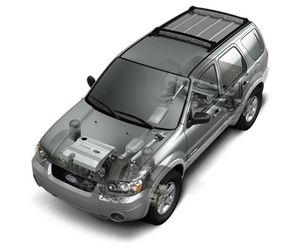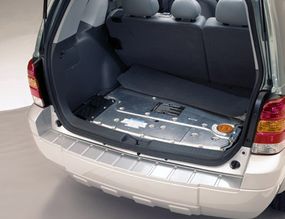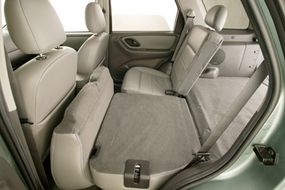Hybrid vehicles offer the best fuel economy of any car on the market by combining an efficient gasoline engine with an electric motor and batteries that are constantly recharged. Until 2005, most hybrid cars were small, and they didn't have much horsepower or cargo space. The Ford Escape Hybrid changes all that.
The Escape Hybrid is an SUV that gets up to 36 miles per gallon. That may not be as ultra-efficient as some hybrids, but it definitely saves the average family of four a lot of money at the gas pump.
Advertisement
In this article, we'll learn about Ford's brand new, patented hybrid powertrain, take a look at the Escape Hybrid's performance and find out why this car could be a major breakthrough for hybrids in the automotive marketplace.
A hybrid car is one that attempts to incorporate the strengths of both gasoline-fueled combustion engines and electric motors while eliminating many of the problems that plague cars that are only one or the other. For gasoline cars, these problems include noise, expensive fuel and polluting emissions. Battery-powered electric cars have always been held back by short battery life and the need to plug the car in to recharge it.
A hybrid car has a combustion engine and an electric motor that work together (either at the same time or separately, depending on the type of hybrid). The image below shows a parallel hybrid car, in which both the gasoline engine and the motor can propel the vehicle.
A hybrid car never needs to be plugged in for a recharge -- whenever you step on the brakes, some of that energy is stored in the batteries. If the batteries get really low, the car can just run on gas until the combustion engine recharges them.
For a more detailed, in-depth explanation of hybrid cars, check out How Hybrid Cars Work.
Now, let's take a look at the Ford Escape Hybrid.
Ford didn't try to design an all-new car for their first foray into the hybrid realm. It started with a proven model, the four-cylinder Ford Escape, and spent five years and 100 engineers (Car and Driver, Dec. 2004) developing a hybrid powertrain to put into it. The Escape itself is recognizable as an SUV, but it is a relatively small one. In that respect, the Escape gets good mileage even without an electric motor: It's rated at 25 mpg on the highway.
So what did all those engineers do to convert the Escape? In terms of looks, not much. Except for the small "Hybrid" logo on the door, a different gauge in the dashboard and a vent in the rear to help cool the batteries, you'd be hard-pressed to tell an Escape Hybrid from the conventional version.

That's the point, really. The reason Ford took so much time developing the Escape Hybrid is that it wanted the car to function just like a regular SUV. The driver doesn't need any special technical skills to operate it. The electric motor and batteries are supposed to operate for the life of the vehicle without maintenance. There isn't even a meter to tell the driver how low the battery charge is getting, because the driver isn't supposed to worry about it. The operation of the hybrid system is as transparent as possible. For all intents and purposes, the Escape Hybrid is just an SUV that gets great mileage and doesn't give off much pollution. That's the reason it could make a significant impact on the U.S. auto market. Making hybrid technology easy for the average buyer to adopt is probably the most innovative aspect of the Escape Hybrid.
Now, let's take a closer look at the nuts and bolts (and wires and batteries) that lie beneath the Escape Hybrid's hood.
Advertisement





